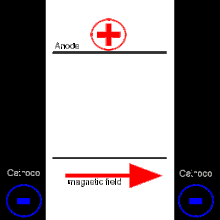Ion getter pump
The ion getter pump , also called ion atomizer pump or getter ion pump , is a form of vacuum pump . With this special form of the sorption pump , the residual gas particles ( atoms or molecules ) are ionized by electron impact and accelerated onto a surface by an electric field . There they can be chemically bonded or implanted and are thus removed from the residual gas. When the ions hit the surface, electrons are released, which can ionize further residual gas particles. Chemically reactive molecules are bound when they hit a getter material (usually titanium ) even without prior ionization . As a result, the pump does not convey the residual gas out of the vacuum chamber, but only holds the pumped atoms on the inside of the pump or "buries" them in the metal. Therefore, the ion getter pump does not have a gas outlet opening either.
When the ions hit the titanium surface, atoms are knocked out of the surface (" cathode sputtering ", hence the name "ion sputtering pump"). As a result, fresh titanium is repeatedly deposited on the opposing electrodes, i.e. the getter layer is permanently renewed.
In order to achieve a more effective ionization of the residual gas atoms or molecules, the electrons have to cover the greatest possible distance. This is achieved by a magnetic field in which the electrons are deflected by the Lorentz force and therefore follow a path similar to a helical line.
This type of pump only works if a high vacuum has already been reached, i.e. if the vacuum chamber has already been pumped out by another pump to a pressure below approx. 10 −3 mbar . With ion getter pumps, a significantly lower pressure can then be achieved; under optimal conditions this can be approx. 10 −11 mbar. Ion getter pumps are not very well suited for noble gases because noble gas pumped out cannot be chemically bound and may be released again under certain circumstances.
Ion getter pumps have no moving parts and are therefore maintenance-free and only require a high-voltage supply (direct voltage, depending on the pump type, 3000–7000 V ) for operation.
Special designs
The ion evaporation pump is an ion getter pump in which the highly reactive getter layer is not generated by cathode sputtering, but by evaporation of the getter material (e.g. by electron bombardment).
A variant of the ion getter pump is the orbitron pump . In order to ionize the largest possible number of residual gas particles, the electrons circulate around a centrally arranged, rod-shaped anode, which is surrounded by a cylindrical cathode.
